Chris Isaak Revisited
Chris Isaak smoothed onto the scene. That’s the only way to describe it.
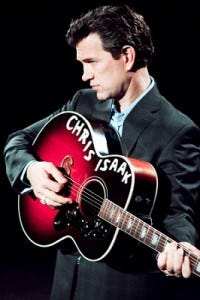
By the time most of us became aware he was there, the Bay Area native was already on his third album. “Wicked Game” from Heart Shaped World, whose video featured Isaak and a topless model rolling around on a beach, made the retro-loving rocker a belated star. Fans quickly became acquainted with the Chris Isaak ethos: a modern viewpoint set against a mix of classic influences, including early rock, Memphis soul, rockabilly, traditional pop, country and Latin grooves. If Isaak was hardly the only retro-rock revivalist to emerge from the mid-80s, he’s been one of the most enduring.
On the side, Isaak has maintained a surprisingly healthy acting career, appearing in everything from The Silence of the Lambs to the Super Bowl episode of Friends. He even starred in an offbeat comedy based on his own life that ran for three seasons on Showtime. He’s been a frequent talk show guest (and briefly helmed his own talk/variety hour). And he’s a tireless road warrior, constantly playing live shows. The 30th anniversary of his major label debut just hit, so now is a good time to take a stroll through the catalogue of Chris Isaak.
Silvertone (1985)
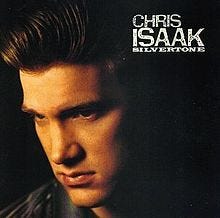
Silvertone may have flown well under the radar upon release, but it accomplished what it needed to: it introduced Chris Isaak as a fully realized artist. That’s not a total shock. Isaak was nearly 30 by the time his debut hit the market and had been perfecting his sound for years. The musical influences of Isaak and his simpatico band were evident in their cool, slick grooves. Isaak himself provided an interesting focal point, with a voice that could smoothly glide from a low, rumbling bass to a keening falsetto. Silvertone mostly plays well as a unified whole, a true album. Isaak’s various influences take turns in the spotlight on different cuts without calling excessive attention to themselves. Perhaps the most memorable song is “Dancin’,” which is also the cut that most effectively translated Isaak’s old school influences into a modern context. At a time when pop and rock airwaves were awash in synthesizers and electric guitars, Isaak and his band crafted a propulsive rock single with intrigue and personality. It nipped at a few playlists, but didn’t quite break through. Also of interest is the gentle “Back On Your Side,” a strong roots ballad that’s become a fan favorite. Silvertone was a confident, assured debut that set out the Chris Isaak template quite effectively. It’s absolutely worth checking out.
Chris Isaak (1986)
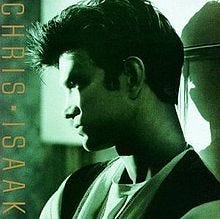
Chris Isaak didn’t take long to release his follow-up. If Chris Isaak pales slightly in comparison to Isaak’s debut, it’s only because it’s less surprising. Sonically, Chris Isaak is very similar to Silvertone. Isaak’s many influences are on display and come to the fore in turn. If this sophomore release is less cohesive overall, it boasts more individual songs that stand out. “You Owe Me Some Kind of Love” cops some rebel attitude and translates its proto-rock/soul influences quite effectively into a modern single. Conversely, “Blue Hotel” is one of the more unabashedly retro songs in Isaak’s early repertoire, but its dynamism and soul carry it far. “This Love Will Last” is a timeless sort of Americana mid-tempo ballad that’s rather lovely and surprisingly optimistic for a singer whose usual musical currencies are heartbreak and the dark side of love. Those cuts have become enduring parts of Isaak’s catalogue and anchor a solid effort. For the record, “Cryin’” is an Isaak original and not a cover of the Roy Orbison classic “Crying.” Looking back on it almost 30 years later, Chris Isaak is enjoyable, but not the place for new fans to start.
Heart Shaped World (1989)
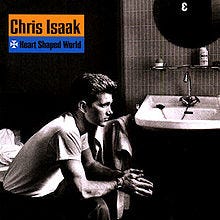
Heart Shaped World became a slow burn success for Chris Isaak and stands as his biggest seller. Originally released in 1989, Heart Shaped World caught fire the following year, when “Wicked Game” appeared in the David Lynch film Wild at Heart. “Game” has become Isaak’s signature, his biggest hit, and it’s no wonder. It was a canny mix of old school blues rock and modern production and attitude. With its slinky, insistent beat and spacey atmosphere, it sounded like nothing else on the radio in 1990. If that were all Heart Shaped World had to offer, it would be enough, but the album is filled with excellent cuts. Isaak and his band did their strongest job yet of bringing their retro influences into a modern setting, delivering lots of diversity and lots of excellent songs. “Wrong To Love You” built into an energetic rocker from a honky tonk base. “Blue Spanish Sky” subtly wove Latin influences into a moody ballad. “Heart Shaped World” provided a spacey, dreamy opener and “Don’t Make Me Dream About You” was a canny update on a classic “lovesick teenager” trope. The album even found space (as a bonus cut) for a pure blues workout in “Diddley Daddy,” now an Isaak concert favorite. It may have taken a long time for it to happen, but Heart Shaped World made Isaak a star and remains an essential moment in his discography.
San Francisco Days (1993)
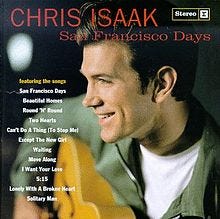
After the breakthrough success of Heart Shaped World, some might have expected Chris Isaak to turn in a carbon copy in pursuit of another hit. While all of Isaak’s albums start with the same shared core of influences, he often sends them off in different directions. San Francisco Days was more pop-oriented in some ways, working in a brighter, more welcoming mode for many of its cuts. The title track opened the album with an energetic mid-tempo approach that incorporated lots of retro pop touches to adorn Isaak’s tale of romantic longing. “Two Hearts” was one Isaak’s best love songs, starting with a hushed intro that opened up into an almost tropical influenced strum. “I Want Your Love” took a more timeless approach to its uptempo groove. The album had plenty of room for the atmosphere-drenched musical noir that Isaak loves, like the low key “Can’t Do A Thing (To Stop Me)” or the sinister shuffle of “5:15.” Isaak played contrasts well, like the energetic workout of “Lonely With A Broken Heart.” He wrapped it all up with a strong, straightforward cover of the Neil Diamond classic “Solitary Man.” San Francisco Days was a strong, diverse outing that featured Isaak in fine form and is something fans shouldn’t overlook.
Forever Blue (1995)
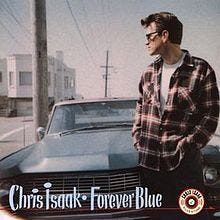
San Francisco Days was a gold level seller, but didn’t generate much radio interest. Chris Isaak returned fairly quickly with Forever Blue, one of his best albums. Blue was a heartbreak album, but subverted that thesis with a varied sonic and tempo approach. Lead single “Somebody’s Crying” put Isaak back on the radio. The loping, mid-tempo plaint was possibly the purest distillation of Isaak’s hero worship of the late Roy Orbison and made for a first rate single that sounded great on the radio. The nasty, low register grumble of “Baby Did A Bad, Bad Thing” and the spaced out grooves of “Graduation Day” both attracted movie soundtrack attention. “Goin’ Nowhere” brought a surf rock approach to a tale of love about to go wrong, “There She Goes” married a surprisingly sunny sonic approach to lyrics about losing your girl, and “Go Walking Down There” caught the ear of radio programmers with a propulsive rhythm framing its mid-tempo distillation of desperation. One of the canniest pieces of musical contrast was “I Believe,” a spirited workout with a cynical lyrical spike that had a lot of bite. Forever Blue didn’t ignore slower material. “Don’t Leave Me On My Own” courted a classic country vibe, while “Things Go Wrong” was a hushed, layered production. Title cut “Forever Blue” was a gorgeous distillation of the “high lonesome” ethos, while “Shadows in a Mirror” was a dark, paranoid ballad. “The End of Everything” was an appropriate capper to the set, a gently picked strummer that quietly concluded with “take your love with you when you go.” Forever Blue worked really well thanks to its singular devotion to its theme of heartbreak and despair. It was an effective melding of retro influences and modern production and stands as an unmissable part of Isaak’s catalogue.
Baja Sessions (1996)
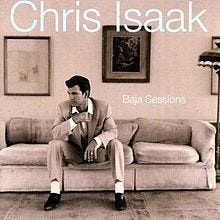
The mellow Baja Sessions was inspired by the Mexican surf trips that Chris Isaak and his band took whenever they could. The instrumental approach was basic and fairly straightforward, mostly acoustic guitars and piano, plus drums, squeezebox and a few other offbeat selections. Electric guitars popped up here and there. But mostly this was Isaak and company hanging out and capturing a mellow vibe. Baja Sessions was a covers project, which was certainly in vogue in the mid-90s. Isaak put a twist on that concept by including several of his own earlier songs in simpler arrangements. Isaak picked tunes that fit into the tropical/Latin setting he and his band wove, essaying classics like “Pretty Girls Don’t Cry,” “Only the Lonely,” “Waiting For My Lucky Day,” “South of the Border (Down Mexico Way)” and “Sweet Leilani” to weave a mesmerizing spell of beachy cool. It was no surprise that Isaak’s own tunes, like “Back On Your Side,” “Two Hearts” and “Dancin’,” fit in almost seamlessly. Baja Sessions isn’t a seminal moment for Chris Isaak, but for diehard fans, it’s a winning, low key gem.
Speak of the Devil (1998)

On Speak of the Devil, Chris Isaak made more of an effort to translate his old school influences into contemporary settings. With more focus on the rock side of his equation, Devil might be one of Isaak’s most modern albums. Lead single “Please” was a good example. Isaak and co. took a muscular, electric guitar approach to enhance the breathy, soul-influenced vocal Isaak worked. The result was an insistent cut that sounded fresh and got Isaak a bit of positive notice. The title track seemed to provide the common ground for Isaak’s ‘50s vintage rock and soul approach with synthesizers and electric guitars, working its way into a spirited, crunching rock attack. “Breaking Apart” took Isaak to the edge of contemporary country pop (a tie he’d make explicit a few years later when he re-recorded the song with Trisha Yearwood, one of the queens of country pop). Most of the cuts on Devil sounded pretty good, even if they were hard to retain afterward. The album ended with an inspired bit of lunacy, “Super Magic 2000,” a spacey, surf/psychedelic instrumental that found Isaak and his band riffing and having fun. It was an entirely random and yet surprisingly agreeable way to cap the set. If Speak of the Devil was a pleasant album, over time it’s probably receded in terms of stature within Isaak’s catalogue.
Always Got Tonight (2002)
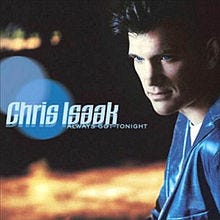
The ‘90s were a busy decade for Chris Isaak. After “Wicked Game” made him a star, he embarked on extensive rounds or promotion and almost constant touring. Between 1993 and 1998, he put out four albums. So it was no shock that the singer took a bit of a breather after Speak of the Devil. Not that he was completely idle. He undertook some acting work, including his Showtime comedy, which debuted in 2001. Like its predecessor, Always Got Tonight devoted a lot of room to the rock side of Isaak’s repertoire and shared its focus in bringing the singer’s retro influences into contemporary settings. Echoes of proto-rock could still be heard in insistent, energetic rockers like “One Day,” “Courthouse” and “Notice the Ring.” The title track even incorporated a subtle tinge of modern R&B to complement its rock sound. Ironically, the album’s lead single, “Let Me Down Easy,” scored at Adult Contemporary radio by infusing a bit more or Isaak’s retro-swoon into the mix, making for a winning, mid-tempo gem. Isaak managed to bring some blues fervor to “Worked It Out Wrong” and some retro-pop flair to “Cool Love.” “Nothing to Say” brought in some rockabilly elements and “American Boy” (the theme to Isaak’s show) was a solid, Americana-infused rocker. In some ways, Always Got Tonight wound up being one of Isaak’s least cohesive albums, but on a song-by-song basis it’s pretty strong and worth hearing.
Best of Chris Isaak (2006)
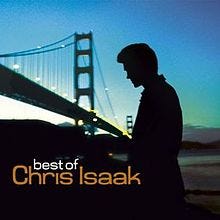
Chris Isaak is an artist well represented by a Best of collection. Heart Shaped World was a multi-platinum seller and the three albums that followed all went gold or better. But Isaak has a long, deep discography filled with great songs, many of which had been overlooked by less devoted listeners. So this Best of provided casual fans with a decent overview of the first two decades of Isaak’s recording career. The biggest hits were accounted for: “Wicked Game,” “Somebody’s Crying,” “Baby Did A Bad, Bad Thing,” “Let Me Down Easy,” “Dancin’” “Can’t Do A Thing (To Stop Me)”and “Please” were all present. Isaak also included several quality album cuts and concert favorites, such as “San Francisco Days,” “Two Hearts,” “Speak of the Devil,” “Blue Hotel” and “Blue Spanish Sky.” He added new cuts “Let’s Have A Party,” “King Without A Castle” and Cheap Trick cover “I Want You To Want Me” as a hook for longer-term fans. Isaak eschewed strict chronology, instead sequencing tracks for maximum impact and to create a good flow. Some might quibble with a couple of omissions (no “Graduation Day,” “Don’t Make Me Dream About You” or “Go Walking Down There”). But for a concise summation of the earlier part of Isaak’s career, Best of Chris Isaak mostly got the job done.
Mr. Lucky (2009)
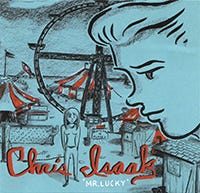
Chris Isaak didn’t go on vacation after delivering his 2002 album Always Got Tonight. The seven years that followed included such classic time buys as a Christmas album and a hits collection, plus a live release for the international market. Isaak also toured extensively and took on some film and TV projects. When a new album finally arrived, fans weren’t sure what to expect. Mr. Lucky moved toward an embrace of pop- and rock-influenced country on several cuts, which wasn’t a bad commercial move in 2009 for a rock star north of age 50. That approach was most evident on the two high profile duets: “Breaking Apart,” where Trisha Yearwood joined Isaak for a remake of his yearning ballad, and “I Lose My Heart,” a strong mid-tempo collaboration with Michelle Branch. Neither cut exactly went for what was passing as modern country at the time, but the rootsy, organic production and duet partners who had enjoyed success on the country charts suggested an openness to work with country radio programmers. That didn’t happen, but the songs themselves were both strong. The album’s best song, the mid-tempo “We Let Her Down,” which set a soaring Isaak vocal against a modern blues-derived rock arrangement, found favor at Adult Alternative radio, but Isaak didn’t really follow up on that success, either. Mr. Lucky contained odd moments like the tropical lounge of “Take My Heart,” but also featured the spirited “Cheater’s Town” and wide open, classic rock-steeped closer “Big Wide Wonderful World.” It wasn’t a coherent album by any means, but featured several strong songs and Isaak sounded great throughout. Isaak hasn’t released much original music since this album and the questions it raised about his place in the modern music cosmography remain unanswered.
Live at the Fillmore (2010)
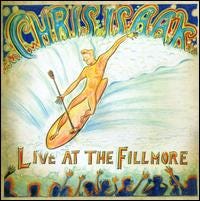
Chris Isaak and his band are known for their live performances. The singer had released an Australian performance to the international market a couple years earlier, but Live at the Fillmore was his first proper live set for the U.S. market. It’s a good document of the live Chris Isaak, featuring plenty of banter and wit from the genial star. Isaak and crew didn’t go in for canned recreations of the studio settings of these songs. They infused each performance with a lot of energy, subtly enhancing some cuts while transforming others. Isaak picked a shrewd blend of hits, concert favorites and album cuts that all fit the mood really well. Isaak’s band is one of the best in the business and has worked with the singer throughout his career. They’re really tight and provided a level of support that’s fairly rare. Live at the Fillmore is recommended for anyone interested in the live performance side of Chris Isaak.
Beyond the Sun (2011)
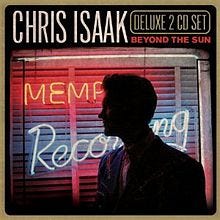
Beyond the Sun was inevitable for Chris Isaak, an “all debts paid” tribute to the pioneer rock, soul, country and rockabilly that are essential to his musical DNA. Recorded at Sun Studios in Memphis, Beyond the Sun featured a collection of classic songs, mixing some iconic hits with lesser known selections from legends like Elvis Presley, Johnny Cash, Jerry Lee Lewis, Chuck Berry, Carl Perkins, Roy Orbison and others. Isaak and his ever-simpatico band weren’t out to recreate these gems. Beyond the Sun was a faithful, period-inspired marathon of classic songs performed the way their originators did it. Isaak wasn’t trying to modernize “Ring of Fire,” “Great Balls of Fire,” “Can’t Help Falling in Love,” “How’s the World Treating You,” “It’s Now or Never,” “Miss Pearl,” “I Walk the Line,” “My Happiness,” “Oh, Pretty Woman” or “I’m Gonna Sit Right Down and Cry.” He reveled in the feel of those classic songs and brought that sensation to his audience. In many ways, it was fairly smart not to tamper with classics that are sacred to a lot of fans. But one can’t help but miss the inventiveness that Isaak and his collaborators have often displayed in translating their influences into modern contexts. Bringing some of that spirit to these songs could have made this two-disc collection great instead of merely good. Isaak got into the spirit with two originals, “Live It Up” and “Lovely Loretta.” Both were fine, retro-spiced nuggets that fit in seamlessly with their inspirations. Beyond the Sun got some nice reviews, but didn’t sell strongly and its sole attempt at a single, “Live It Up,” found no traction. These recordings represented a niche product and didn’t have a place in the broad commercial firmament of 2011. But then, it wasn’t clear that Isaak was even looking for one. That’s admirable, a pure artistic impulse to record songs he’d loved all his life. But it also was the last collection that fans have received from the singer as of this writing. By 2015, Isaak has delivered only two sets of original songs in 13 years (Always Got Tonight in 2002 and Mr. Lucky in 2009). As enjoyable as Beyond the Sun often was, it provided no clues as to where Isaak might go next or if he intends to go anywhere.
Originally published at thunderalleybcpcom.ipage.com on February 17, 2015.
